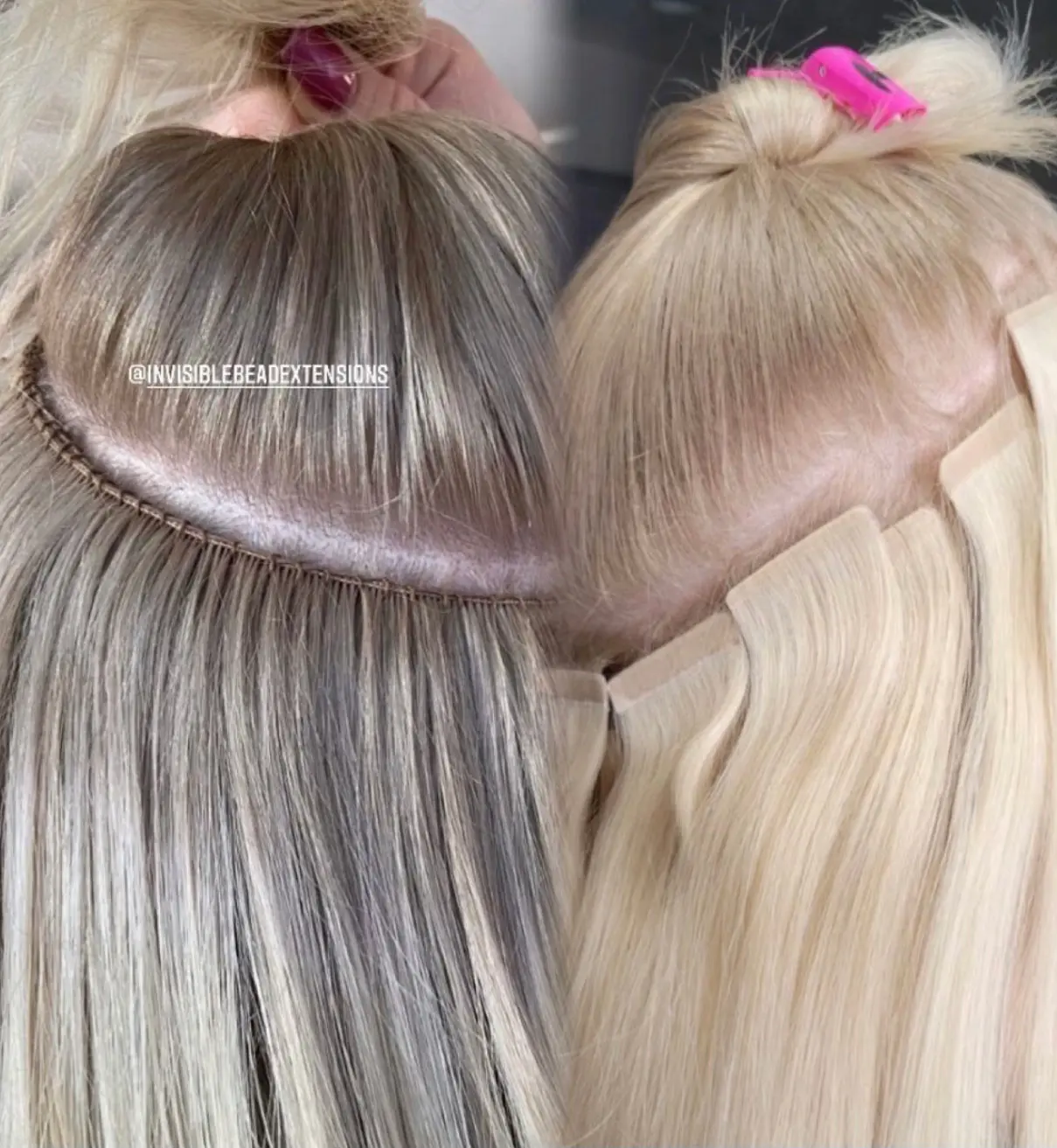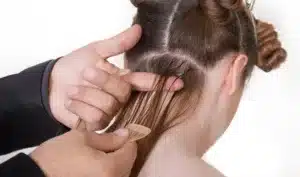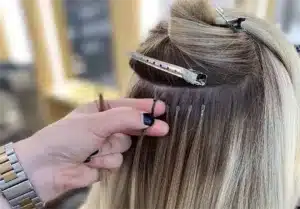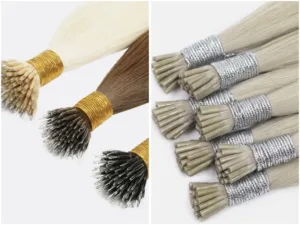Hand tied extensions vs tape in—what’s the better option? For salon professionals, this isn’t just a technical choice. It shapes service pricing, installation time, and client satisfaction.
Tape-ins are fast, lightweight, and ideal for quick transformations. Hand-tied wefts offer longer-lasting, natural-looking volume with less product visibility.

Both systems deliver beautiful results. But they serve different needs. Let’s go deeper and decide which is best for your salon or wholesale catalog.
What Are Tape-In Extensions?
Tape-ins solve a common salon problem: how to give clients full, voluminous hair in under an hour.
Tape-in extensions are pre-taped hair strips that sandwich natural hair between two bonded wefts. They are applied without heat or glue.

Dive Deeper: Benefits and Structure of Tape-Ins
Tape-ins are one of the most flexible options for stylists today. They are reusable, lightweight, and allow for fast application and removal without damage when installed properly.
Key Features:
- Pre-taped PU strips ready to install
- Lay flat against the scalp
- Can be reused 2–3 times
- Great for adding length or volume
Who They Suit:
- Clients with fine or medium hair
- Short-term transformations
- Salons with high client turnover
- Online retail customers
However, they require clean hair for adhesion, and tape may slip if oils or products are used improperly. Tape-ins must be moved up every 6–8 weeks. Tapes also need to be replaced after 2–3 uses.
What Are Hand Tied Extensions?
Hand-tied extensions are a favorite among stylists who value subtlety and long wear.
Hand-tied extensions are ultra-thin wefts sewn by hand. They are installed using a bead-and-sew method with no glue or tape.

Dive Deeper: Why Hand-Tied Wefts Are a Pro Staple
Hand-tied extensions provide a natural, seamless look. Their ultra-thin base blends perfectly into the scalp. They don’t create bulk and are ideal for clients who want full hair without visible seams.
Key Features:
- No tape or glue
- Strong, flat weft
- Can be layered for volume
- Safe for most hair types
Who They Suit:
- Medium to thick hair clients
- Long-term wear (8–10 weeks per install)
- Stylists offering high-end luxury services
- Clients who avoid adhesive methods
Installations take longer, but the results are worth it. Maintenance includes moving them up every 6–10 weeks, depending on growth. With proper care and high-quality hair (like full cuticle hand-tied wefts from Hibiscus Hair), they can be reused for 12+ months.
Tape Ins vs Hand Tied Extensions
Tape-ins and hand-tied extensions serve different purposes. Let’s compare the key factors that influence professional choices.
Dive Deeper: Technical Comparison
| Category | Tape-In Extensions | Hand Tied Extensions |
|---|---|---|
| Application | Sandwich method, taped | Beaded row + sew-in |
| Installation Time | 30–60 minutes | 2–3 hours |
| Removal | Quick, with tape remover | Time-consuming, requires scissors |
| Durability | 6–8 weeks per install | 8–10 weeks per install |
| Maintenance | Re-tape and move up every 6 weeks | Tighten row, reposition every 8–10 weeks |
| Cost | Lower upfront, more frequent upkeep | Higher upfront, lower maintenance |
| Hair Health | Minimal if installed correctly | Minimal with tension control |
| Scalp Sensitivity | Tape may irritate sensitive skin | Beads may cause tension if too tight |
Both are safe when installed by a trained professional. Tape-ins require careful sectioning and product-free hair. Hand-tied extensions demand skill in tension control and beading.
My Opinion
Both systems work well depending on the client and business model. For salons that need fast results and frequent changeovers, tape-ins are efficient. For high-end services or clients looking for long-term transformation, I always recommend hand-tied extensions.
At Hibiscus Hair, we manufacture both with full cuticle, single-donor hair. Our hand-tied wefts remain one of our best-selling lines to professionals who prioritize natural results and long wear.

FAQ
1. Can I install tape-ins on oily hair?
No. Tape requires a clean, dry base for strong adhesion.
2. How often should I move up hand-tied extensions?
Every 6–10 weeks, depending on the client’s natural growth.
3. Do hand-tied extensions damage natural hair?
Not if installed properly. Proper beading tension and spacing protect the scalp.
4. Which system is better for thin hair?
Tape-ins work better on fine hair. Hand-tied wefts need more base hair to secure.
5. Are both methods reusable?
Yes. Full cuticle hair can be reused. Tape wefts need new tape each time.
6. Can I sleep with both types?
Yes, with a loose braid or low ponytail to prevent tangling.
7. Are hand-tied extensions invisible?
Yes. When installed properly, they lay flat and blend seamlessly.
8. Do tape-ins fall out easily?
If installed on clean hair with no oil or conditioner, they hold well.
9. Can both be dyed or styled?
Yes. As long as you use full cuticle human hair, like Hibiscus Hair offers.
10. Which sells better online?
Tape-ins sell more online due to ease of use and lower entry cost.
Conclusion
Choose tape-ins for speed and simplicity. Choose hand-tied for luxury and longevity. Offer both to meet every client need.
Hibiscus Hair Manufacturer has been dedicated to producing high-quality hair extensions for 25 years and is a recognized leader in the industry. If you are interested in finding a reliable hair extensions supplier and wholesale for your brand, please visit our website for more information:
Hand tied Weft Hair Extensions
TAPE IN HAIR




